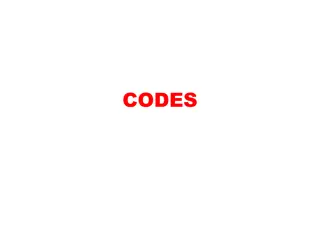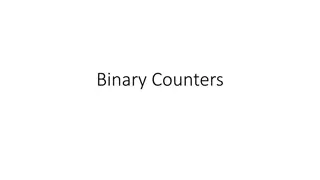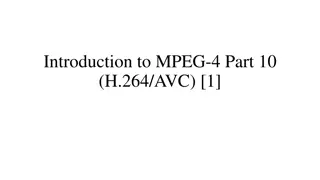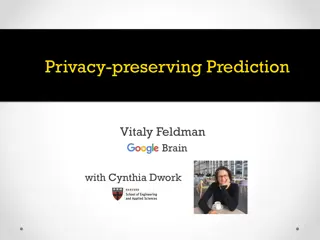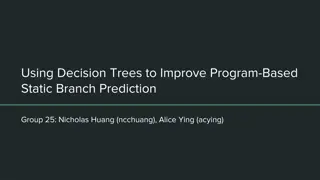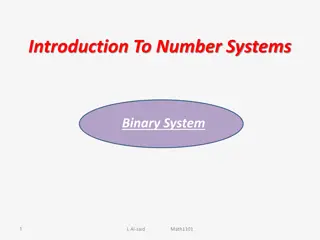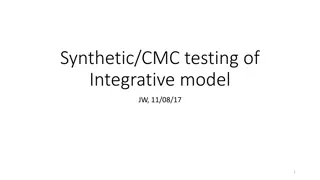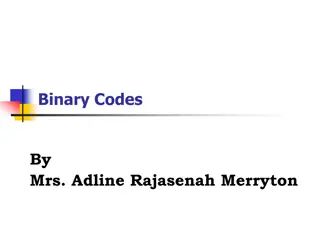Binary Outcome Prediction Models in Data Science
Categorical data outcomes often involve binary decisions, such as re-election of a president or customer satisfaction. Prediction models like logistic regression and Bayes classifier are used to make accurate predictions based on categorical and numerical features. Regression models, both discriminative and generative, play a crucial role in supervised learning by classifying outcomes directly from data and optimizing objective functions to improve predictions.
Download Presentation

Please find below an Image/Link to download the presentation.
The content on the website is provided AS IS for your information and personal use only. It may not be sold, licensed, or shared on other websites without obtaining consent from the author.If you encounter any issues during the download, it is possible that the publisher has removed the file from their server.
You are allowed to download the files provided on this website for personal or commercial use, subject to the condition that they are used lawfully. All files are the property of their respective owners.
The content on the website is provided AS IS for your information and personal use only. It may not be sold, licensed, or shared on other websites without obtaining consent from the author.
E N D
Presentation Transcript
Logistic Regression Thomas Schwarz
Categorical Data Outcomes can be categorical Often, outcome is binary: President gets re-elected or not Customer is satisfied or not Often, explanatory variables are categorical as well Person comes from an under-performing school Order was made on a week-end
Prediction Models for Binary Outcomes Famous example: Taken an image of a pet, predict whether this is a cat or a dog
Prediction Models for Binary Outcomes Bayes: generative classifier Predicts indirectly ?(?|?) ? = arg max? ??(?|?)?(?) Likelihood Prior Evaluates product of likelihood and prior Prior: Probability of a category ? without looking at data Likelihood: Probability of observing data if from a category ?
Prediction Models for Binary Outcomes Regression is a discriminative classifier Tries to learn directly the classification from data E.g.: All dog pictures have a collar Collar present > predict dog Collar not present > predict cat Computes directly ?(?|?)
Prediction Models for Binary Outcomes Regression: Supervised learning: Have a training set with classification provided Input is given as vectors of numerical features ?(?)= (?1,?,?2,?, ,??,?) Classification function that calculates the predicted class ? An objective function for learning: Measures the goodness of fit between true outcome and predicted outcome An algorithm to optimize the objective function (?)
Prediction Models for Binary Outcomes Linear Regression: Classification function of type ? (?1,?2, ,??) = ?1?1+ ?2?2+ ????+ ? Objective function (a.k.a cost function) Sum of squared differences between predicted and observed outcomes E.g. Test Set ? = {?(1),?(2), ?(?)} ? Minimize cost function (?(?) ? (?))2 ?=1
Prediction Models for Binary Outcomes Linear regression can predict a numerical value It can be made to predict a binary value If the predictor is higher than a cut-off value: predict yes Else predict no But there are better ways to generate a binary classifier
Prediction Models for Binary Outcomes Good binary classifier: Since we want to predict the probability of a category based on the features: Should look like a probability Since we want to optimize: Should be easy to differentiate Best candidate classifier that has emerged: Sigmoid classifier
Logistic Regression Use logistic function 1 ?(?) = 1+exp( ?)
Logistic Regression Combine with linear regression to obtain logistic regression approach: Learn best weights in ? (?1,?2, ,??) = ?(? + ?1?1+ ?2?2+ ????) We know interpret this as a probability for the positive outcome '+' Set a decision boundary at 0.5 This is no restriction since we can adjust ? and the weights
Logistic Regression We need to measure how far a prediction is from the true value Our predictions ? 1 and the true value ? can only be 0 or If ? = 1: Want to support ? = 0. = 1 and penalize ? If ? = 0: Want to support ? = 1. One successful approach: = 0 and penalize ? ?( )(1 ?) ( )
Logistic Regression Easier: Take the negative logarithm of the loss function Cross Entropy Loss LCE= ?log(? ) (1 ?)log(1 ? )
Logistic Regression This approach is successful, because we can use Gradient Descent Training set of size ? ? Minimize LCE(?(?),? (?)) ?=1 Turns out to be a convex function, so minimization is simple! (As far as those things go) Recall: ? = ?(? + ?1?1+ ?2?2+ ????) We minimize with respect to the weights and ? (?1,?2, ,??)
Logistic Regression Calculus: ?LCE(?,?) ??? = ?(?1?1+ ????+ ?) ? ?? = (? ?)?? Difference between true ? and estimated outcome ? multiplied by input coordinate ,
Logistic Regression Stochastic Gradient Descent Until gradient is almost zero: For each training point ?(?),?(?): Compute prediction ? Compute loss Compute gradient Nudge weights in the opposite direction using a learning weight ? (?1, ,??) (?1, ,??) ??LCE Adjust ? (?)
Logistic Regression Stochastic gradient descent uses a single data point Better results with random batches of points at the same time
Lasso and Ridge Regression If the feature vector is long, danger of overfitting is high We learn the details of the training set Want to limit the number of features with positive weight Dealt with by adding a regularization term to the cost function Regularization term depends on the weights Penalizes large weights
Lasso and Ridge Regression L2 regularization: Use a quadratic function of the weights Such as the euclidean norm of the weights Called Ridge Regression Easier to optimize
Lasso and Ridge Regression L1 regularization Regularization term is the sum of the absolute values of weights Not differentiable, so optimization is more difficult BUT: effective at lowering the number of non-zero weights Feature selection: Restrict the number of features in a model Usually gives better predictions
Examples Example: quality.csv Try to predict whether patient labeled care they received as poor or good
Examples First column is an arbitrary patient ID we make this the index One column is a Boolean, when imported into Python so we change it to a numeric value df = pd.read_csv('quality.csv', sep=',', index_col=0) df.replace({False:0, True:1}, inplace=True)
Examples Farmington Heart Data Project: https://framinghamheartstudy.org Monitoring health data since 1948 2002 enrolled grandchildren of first study
Examples Contains a few NaN data We just drop them df = pd.read_csv('framingham.csv', sep=',') df.dropna(inplace=True)
Logistic Regression in Stats-Models Import statsmodels.api import statsmodels.api as sm Interactively select the columns that gives us high p- values cols = [ 'Pain', 'TotalVisits', 'ProviderCount', 'MedicalClaims', 'ClaimLines', 'StartedOnCombination', 'AcuteDrugGapSmall',]
Logistic Regression in Stats-Models Create a logit model Can do as we did for linear regression with a string Can do using a dataframe syntax logit_model=sm.Logit(df.PoorCare,df[cols]) result=logit_model.fit() Print the summary pages print(result.summary2())
Logistic Regression in Stats-Models Print the results This gives the "confusion matrix" Coefficient [i,j] gives: predicted i values actual j values print(result.pred_table())
Logistic Regression in Stats-Models Quality prediction: [[91. 7.] [18. 15.]] 7 False negative and 18 false positives
Logistic Regression in Stats-Models Heart Event Prediction: [ 523. 34.]] [[3075. 26.] 26 false negatives 523 false positives
Logistic Regression in Stats-Models Can try to improve using Lasso result=logit_model.fit_regularized()
Logistic Regression in Stats-Models Can try to improve selecting only columns with high P- values Optimization terminated successfully. Current function value: 0.423769 Iterations 6 Results: Logit ================================================================ Model: Logit Pseudo R-squared: 0.007 Dependent Variable: TenYearCHD AIC: 3114.2927 Date: 2020-07-12 18:18 BIC: 3157.7254 No. Observations: 3658 Log-Likelihood: -1550.1 Df Model: 6 LL-Null: -1560.6 Df Residuals: 3651 LLR p-value: 0.0019166 Converged: 1.0000 Scale: 1.0000 No. Iterations: 6.0000 ---------------------------------------------------------------- Coef. Std.Err. z P>|z| [0.025 0.975] ---------------------------------------------------------------- currentSmoker 0.0390 0.0908 0.4291 0.6679 -0.1391 0.2170 BPMeds 0.5145 0.2200 2.3388 0.0193 0.0833 0.9457 prevalentStroke 0.7716 0.4708 1.6390 0.1012 -0.1511 1.6944 prevalentHyp 0.8892 0.0983 9.0439 0.0000 0.6965 1.0818 diabetes 1.4746 0.2696 5.4688 0.0000 0.9461 2.0030 totChol -0.0067 0.0007 -9.7668 0.0000 -0.0081 -0.0054 glucose -0.0061 0.0019 -3.2113 0.0013 -0.0098 -0.0024 ================================================================
Logistic Regression in Stats-Models Select the columns cols = ['currentSmoker', 'BPMeds', 'prevalentStroke', 'prevalentHyp', 'diabetes', 'totChol','glucose'] Get a better (?) confusion matrix: [ 549. 8.]] [[3086. 15.] False negatives has gone down False positives has gone up
Logistic Regression in Scikit-learn Import from sklearn from sklearn.linear_model import LogisticRegression from sklearn import metrics from sklearn.metrics import confusion_matrix from sklearn.model_selection import train_test_split from sklearn.metrics import classification_report
Logistic Regression in Scikit-learn Create a logistic regression object and fit it on the data logreg = LogisticRegression() logreg.fit(X=df[cols], y = df.TenYearCHD) y_pred = logreg.predict(df[cols]) confusion_matrix = confusion_matrix(df.TenYearCHD, y_pred) print(confusion_matrix)
Logistic Regression in Scikit-learn Scikit-learn uses a different algorithm Confusion matrix on the whole set is [[3087 14] [ 535 22]]
Logistic Regression in Scikit-learn Can also divide the set in training and test set X_train, X_test, y_train, y_test = train_test_split(df[cols], df.TenYearCHD, test_size=0.3, random_state=0) logreg.fit(X_train, y_train) y_pred = logreg.predict(X_test) confusion_matrix = confusion_matrix(y_test, y_pred) print(confusion_matrix)
Logistic Regression in Scikit-learn Confusion matrix [[915 1] [176 6]]
Measuring Success precision recall f1-score support 0 0.84 1.00 0.91 916 1 0.86 0.03 0.06 182 accuracy 0.84 1098 macro avg 0.85 0.52 0.49 1098 weighted avg 0.84 0.84 0.77 1098
Measuring Success How can we measure accuracy? accuracy = (fp+fn)/(tp+tn+fp+fn) Unfortunately, because of skewed data sets, often very high precision = tp/(tp+fp) recall = tp/(tp+fn) F measure = harmonic mean of precision and recall
Probit Regression Instead of using the logistic function ?, can also use the cumulative distribution function of the normal distribution 2 ? 0 Predictor is then 1 21 + erf(? + ?1?1+ ?2?2+ + ????) ?exp( ?2)?? erf(?) =
Probit Regression Calculations with probit are more involved Statsmodels implements it Fit the probit model from statsmodels.discrete.discrete_model import Probit probit_model=Probit(df.TenYearCHD,df[cols]) result=probit_model.fit() print(result.summary()) print(result.pred_table()) for i in range(20): print(df.TenYearCHD.iloc[i], result.predict(df[cols]).iloc[i])
Probit Regression Confusion matrix is now [[3085. 16.] [ 547. 10.]] More false positives but less false negatives
Multinomial Logistic Regression Want to predict one of several categories based on feature vector Use the softmax function softmax ?1,?2, ,?? = ?=1 ?=1 ?=1 ??1 ? ??2 ? ??? ? ???, ???, , ???
Multinomial Logistic Regression Learning is still possible, but more complicated
Multinomial Logistic Regression model1 = LogisticRegression(random_state=0, multi_class='multinomial', penalty='none', solver='newton-cg').fit(X_train, y_train) preds = model1.predict(X_test)
Final Example Spine data Col1 63.0278175 39.05695098 68.83202098 69.29700807 49.71285934 40.25019968 Col2 Col3 22.55258597 10.06099147 22.21848205 24.65287791 9.652074879 13.92190658 Col4 Col5 39.60911701 25.01537822 50.09219357 44.31123813 28.317406 25.1249496 Col6 Col7 40.47523153 28.99595951 46.61353893 44.64413017 40.06078446 26.32829311 Col8 Col9 98.67291675 114.4054254 105.9851355 101.8684951 108.1687249 130.3278713 Col10Col11Col12Class_att -0.2543999860.744503464 4.564258645 -3.5303173140.474889164 11.21152344 7.918500615 2.230651729 12.566114.538615.30468 12.887417.532316.78486 26.834317.486116.65897 23.560312.707411.42447 35.49415.95468.87237-16.378376 29.32312.003610.40462 -28.658501 -25.530607 -29.031888 -30.470246 43.5123Abnormal 16.1102Abnormal 19.2221Abnormal 18.8329Abnormal 24.9171Abnormal -1.512209 9.6548Abnormal 0.415185678 Prediction is done by using binary classification. 0.369345264 0.543360472 0.789992856 Attribute1 = pelvic_incidence (numeric) Use explanations to give column names Remove last column
Final Example back_data = pd.read_csv("spine.csv") del back_data['Unnamed: 13'] back_data.columns = ['pelvic_incidence','pelvic tilt', 'lumbar_lordosis_angle','sacral_slope', 'pelvic_radius','degree_spondylolisthesis', 'pelvic_slope','Direct_tilt','thoracic_slope', cervical_tilt','sacrum_angle','scoliosis_slope', Status'] print(back_data.Status.describe())
Final Example Can also change the values of Status Column to 0 or 1 back_data.loc[back_data.Status=='Abnormal','Status'] = 1 back_data.loc[back_data.Status=='Normal','Status'] = 0 X = back_data.iloc[:, :12] y = back_data.iloc[:, 12]




